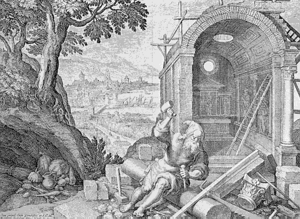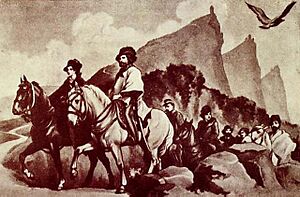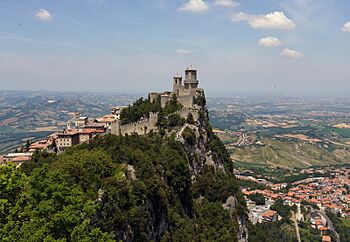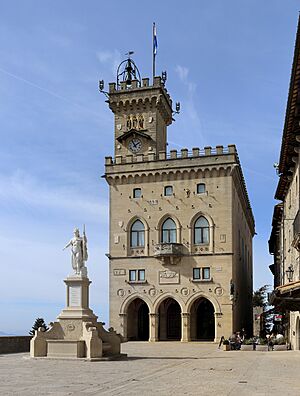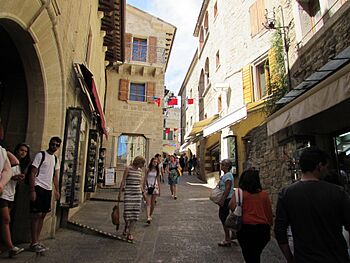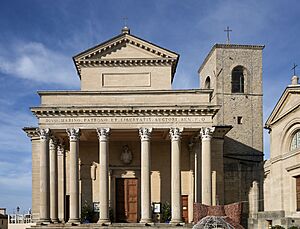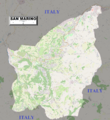San Marino facts for kids
Quick facts for kids
Most Serene Republic of San Marino
Serenissima Repubblica di San Marino (Italian)
|
|
|---|---|
|
|
|
|
Motto: Libertas (Latin: "Freedom")
|
|
|
Anthem: Inno Nazionale della Repubblica di San Marino
|
|
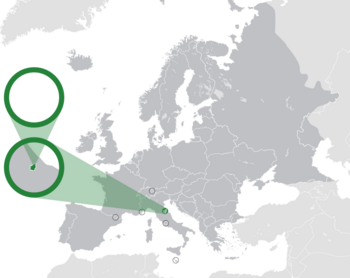
Location of San Marino (green)
on the European continent (dark grey) |
|
| Capital | City of San Marino 43°56′N 12°26′E / 43.933°N 12.433°E |
| Largest settlement | Dogana 43°58′53″N 12°29′22″E / 43.98139°N 12.48944°E |
| Official languages | Italian |
| Other languages | Romagnol |
| Religion | 91.5% Christianity 7.5% no religion 1.0% other |
| Demonym(s) | Sammarinese |
| Government | Unitary parliamentary diarchic directorial republic |
|
• Secretary for Foreign and Political Affairs
|
Luca Beccari |
| Legislature | Grand and General Council |
| Independence | |
|
• From the Roman Empire
|
3 September 301 (traditional) |
|
• From the Papal States
|
1291 |
|
• Constitution
|
|
| Area | |
|
• Total
|
61.19 km2 (23.63 sq mi) (191st) |
|
• Water (%)
|
0 |
| Population | |
|
• 2024 estimate
|
35,436 (191st) |
|
• Density
|
579/km2 (1,499.6/sq mi) (24th) |
| GDP (PPP) | 2024 estimate |
|
• Total
|
|
|
• Per capita
|
|
| GDP (nominal) | 2024 estimate |
|
• Total
|
|
|
• Per capita
|
|
| HDI (2022) | very high · 43rd |
| Currency | Euro (€) (EUR) |
| Time zone | UTC+01 (CET) |
|
• Summer (DST)
|
UTC+02 (CEST) |
| Driving side | right |
| Calling code | +378 (+39 0549 calling via Italy) |
| ISO 3166 code | SM |
| Internet TLD | .sm |
|
Sources:
|
|
San Marino is a small country in Europe. It is officially called the Most Serene Republic of San Marino. It is the oldest existing republic in the world and one of the smallest countries in Europe, besides Vatican City. San Marino is completely surrounded by Italy.
This tiny country is located on the northeastern side of the Apennine Mountains. It is the fifth-smallest country in the world. Its land area is just over 61 square kilometers (23.5 square miles). In 2023, its population was about 33,642 people.
San Marino is a landlocked country, meaning it has no coast. However, its northeastern edge is only about 10 kilometers (6 miles) from the Adriatic Sea coast, near the Italian city of Rimini. The capital city, City of San Marino, sits on top of Monte Titano. The largest town is Dogana, which is part of the Serravalle area. The official language of San Marino is Italian.
The country gets its name from Saint Marinus. He was a stonemason from an island called Rab, which is now in Croatia. Legend says he was born in 275 AD. He helped rebuild the city walls of Rimini. Later, in 301 AD, he started a community on Monte Titano. This is why San Marino claims to be the oldest independent country and the oldest republic with a constitution.
San Marino has a unique system. Its constitution says that its elected government, the Grand and General Council, must choose two leaders every six months. These leaders are called the Captains Regent. They serve at the same time and have equal power.
The country's economy is strong. It mainly relies on finance, industry, services, retail, and tourism. San Marino is one of the richest countries in the world when you look at its wealth per person. It is also the first country to ever abolish the death penalty.
Contents
History of San Marino
Stories say that Saint Marinus left his home island of Rab (in today's Croatia) with his friend Leo. They went to Rimini to work as stonemasons. After being persecuted for his Christian beliefs, Marinus escaped to Monte Titano. There, he built a small church. This is how the city and state of San Marino began.
Historians say that these stories mix facts with legends. The first real proof of a community in San Marino comes from the 5th or 6th century AD. In 1291, San Marino gained tax freedom from a local lord. In 1320, the nearby community of Chiesanuova joined San Marino. In 1463, San Marino grew bigger by adding four more communities: Faetano, Fiorentino, Montegiardino, and Serravalle. The country's borders have stayed the same ever since.
In 1503, Cesare Borgia took over San Marino for six months. But the Pope at the time, Pope Julius II, stepped in and gave San Marino its independence back. Later, in 1543, another attempt to conquer the republic failed when the attackers got lost in a thick fog. People in San Marino believed this was a miracle.
In 1631, San Marino asked the Papal States for protection. This was because the Papal States had taken over the nearby Duchy of Urbino, surrounding San Marino. However, this protection did not mean the Pope controlled San Marino.
In 1739, a Papal governor tried to take over San Marino. But Pope Clement XII restored its independence on February 5, 1740. This day is now a special holiday for Saint Agatha, who became a patron saint of the republic.
When Napoleon's army advanced in 1797, San Marino's independence was at risk. But one of its leaders, Antonio Onofri, became friends with Napoleon. Napoleon promised to protect San Marino's independence and even offered to make its territory larger. The leaders of San Marino politely refused the offer, fearing problems with other countries later.
During the Unification of Italy in the 1800s, San Marino became a safe place for people who supported a united Italy. This included Giuseppe Garibaldi, a famous Italian general. Garibaldi respected San Marino's independence. In 1862, San Marino and the new Kingdom of Italy signed a friendship agreement.
The government of San Marino even made U.S. President Abraham Lincoln an honorary citizen. He wrote back, saying that San Marino showed that a government based on freedom can last a long time.
San Marino in the 20th Century
During World War I, San Marino stayed neutral. Italy was suspicious and cut its telephone lines. However, some volunteers from San Marino joined the Italian forces. They fought or worked in a Red Cross hospital.
After the war, San Marino faced high unemployment and rising prices. This led to political changes. A group called the Sammarinese Fascist Party took power from 1923 to 1943. They were similar to the Fascist party in Italy.
During World War II, San Marino remained neutral. There was a false report that it had declared war on the United Kingdom. San Marino quickly corrected this. In 1943, the Fascist government fell, and San Marino declared neutrality again.
In June 1944, Allied planes bombed San Marino by mistake. They thought German forces were using the country for supplies. San Marino stated that it had no military bases and no foreign soldiers. San Marino took in thousands of refugees during the war. In September 1944, German forces briefly occupied it but were defeated by the Allies in the Battle of San Marino. Allied troops stayed for two months before leaving.
San Marino joined the Council of Europe in 1988 and the United Nations in 1992. It is not part of the European Union, but it uses the euro currency. Before the euro, it used its own currency, the Sammarinese lira.
Geography and Climate
San Marino is in Southern Europe and is completely surrounded by Italy. It is about 10 kilometers (6 miles) from the Adriatic coast near Rimini. The country has many hills and is part of the Apennine Mountains.
The highest point is the top of Monte Titano, which is 749 meters (2,457 feet) above sea level. The lowest point is the Ausa River, at 55 meters (180 feet). San Marino does not have any large lakes or rivers.
It is one of only three countries in the world completely surrounded by another country. The other two are Vatican City (also in Italy) and Lesotho (in South Africa). San Marino is the third smallest country in Europe, after Vatican City and Monaco. It is the fifth-smallest country in the world.
San Marino's Climate
San Marino has a climate with warm to hot summers and cool winters. This is typical for inland areas in central Italy. Rain falls throughout the year, with no truly dry months. Snow is common and can be heavy in winter, especially on higher ground.
Government and Leadership
San Marino is a representative democratic republic. This means people elect representatives to make decisions. The government carries out the laws. While there isn't a formal prime minister, the Secretary for Foreign and Political Affairs acts like one.
The power to make laws belongs to both the government and the Grand and General Council. The courts in San Marino are separate from the government and law-making bodies.
San Marino is known for having some of the oldest written government rules still in use. The Statutes of 1600 are still a key part of its laws.
San Marino was first led by the Arengo, which was made up of the heads of each family. In the 13th century, the Grand and General Council took over. In 1243, the first two Captains Regent were chosen by the council. Even today, two Captains Regent are elected every six months by the council.
The Grand and General Council is the law-making body. It has 60 members. Elections happen every five years. All citizens aged 18 or older can vote.
Besides making laws, the council approves the country's budget. It also elects the Captains Regent and other important groups. These include the State Congress (who have executive power) and the Council of Twelve (who handle judicial matters). The council can also agree to treaties with other countries.
Every six months, the council chooses two Captains Regent to be the heads of state. They are chosen from different political groups to keep power balanced. They serve for six months. If citizens have complaints about the Captains' actions after their term, they can report them.
This system of having two heads of state elected often comes from the ancient Roman Republic. The council is like the Roman Senate, and the Captains Regent are like the consuls of ancient Rome. People believe that when Roman rule ended, the local people came together to form a government to protect themselves.
San Marino has had more female heads of state than any other country. As of October 2014, 15 women had served in this role, with three of them serving twice.
Administrative Divisions
San Marino is divided into nine areas called castelli (which means "castles"). Each castello has a main town and smaller villages called curazie. Each castello is led by a Castle Captain and a Castle Council, who are elected every five years.
The nine castelli are:
- City of San Marino (the capital)
- Acquaviva
- Borgo Maggiore
- Chiesanuova
- Domagnano
- Faetano
- Fiorentino
- Montegiardino
- Serravalle
Economy and Tourism
San Marino's main industries include banking, electronics, and ceramics. The country also produces wine and cheese. San Marino mostly imports basic goods from Italy.
San Marino has one of the highest rates of car ownership in the world. It is one of the few countries where there are more cars than people!
Tourism is very important to San Marino's economy. It makes up over 22% of the country's total income. In 2014, about 2 million tourists visited San Marino.
Population and Culture
As of September 2023, San Marino has about 33,896 residents. Most of them are citizens of San Marino, while many others are Italian citizens.
The main language spoken is Italian. The Romagnol dialect is also widely spoken.
Religion in San Marino
San Marino is mostly a Catholic country. About 97% of the people said they were Catholic in 2011. About half of them go to church regularly. However, Catholicism is not the official state religion.
San Marino's Culture
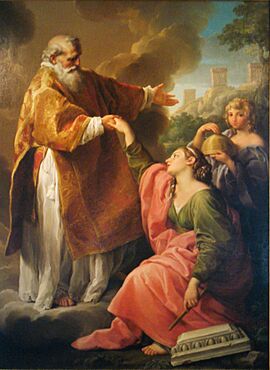
The Three Towers of San Marino are famous landmarks. They are located on the three peaks of Monte Titano in the capital city. You can see them on both the flag of San Marino and its coat of arms.
- Guaita is the oldest tower, built in the 11th century.
- Cesta was built in the 13th century and is on the highest peak of Monte Titano.
- Montale was built in the 14th century and is on the smallest peak. It is still privately owned.
Education and Learning
The main university is the Università degli Studi della Repubblica di San Marino (University of the Republic of San Marino). It has a special school for historical studies. There is also an important music school called the Istituto Musicale Sammarinese.
Sports in San Marino
Football is the most popular sport in San Marino. Basketball and volleyball are also popular. Each sport has its own federation.
The San Marino national football team is not very successful. Most players are part-timers. The team has never qualified for a major tournament. However, they have won three matches in their history. Their first two wins were 1–0 victories against Liechtenstein. Their third win, a 3-1 victory against Liechtenstein, was their first away win. This win also helped San Marino get promoted to a higher league in the UEFA Nations League, which is a big achievement for the team. They have also had four draws, including a 0–0 draw with Turkey in 1993. In that same game, Davide Gualtieri scored a goal just 8.3 seconds into the match against England. This was the fastest goal in international football until 2016.
San Marino has a football club that plays in the Italian league system. There is also a local amateur league called the Campionato Sammarinese.
A Formula One race, the San Marino Grand Prix, was named after the country. But it was actually held in Imola, Italy, about 100 kilometers (62 miles) away. This race was removed from the calendar in 2007.
The San Marino and Rimini's Coast motorcycle Grand Prix is held at the Misano World Circuit in Italy.
San Marino also has a professional baseball team that plays in Italy's top league. They have won the European Cup tournament several times.
Shooting is also very popular. At the 2020 Summer Olympics, Alessandra Perilli won a bronze medal in trap shooting. This made San Marino the smallest country to ever win an Olympic medal. She later won a silver medal with Gian Marco Berti in the mixed trap shooting event.
Sammarinese Cuisine
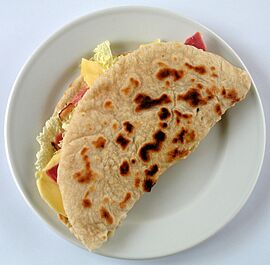
The food in San Marino is very similar to central Italian cuisine, especially from the nearby regions of Emilia-Romagna and Marche. However, San Marino has some unique dishes. The most famous is probably the Torta Tre Monti ("Cake of the Three Mountains"). This is a layered wafer cake covered in chocolate, designed to look like the Three Towers of San Marino. The country also has a small wine industry.
UNESCO World Heritage Site
The historic center of San Marino and Monte Titano became a UNESCO World Heritage Site in 2008. This means they are recognized as very important places for everyone in the world to protect.
Music and Theatre
San Marino has a rich musical history, connected to Italy's music but also unique. A famous composer from the 17th century was Francesco Maria Marini. The pop singer Little Tony was very successful in the 1950s and 1960s.
San Marino has participated in the Eurovision Song Contest eleven times. They have reached the final three times.
The Teatro Nuovo (Serravalle) is the largest theatre in San Marino. It is located in Dogana, near the Italian border.
Museums and Galleries
San Marino has several national museums and galleries:
- Museo delle Armi Antiche: This museum shows old weapons, uniforms, armor, and experimental weapons.
- Museo di Stato: The State Museum has a collection of art and objects about the Republic's history. It includes paintings by famous artists like Guercino.
- Pinacoteca di San Francesco: This art gallery displays old archaeological finds, art, and coins.
- Galleria Nazionale: The National Gallery works to protect and show the country's UNESCO heritage.
- Museo del Francobollo e della Moneta: This museum is dedicated to San Marino's stamps and coins.
- Galleria d’Arte Moderna e Contemporanea: This gallery has over 1,000 modern and contemporary artworks.
- Museo dell’Emigrante: The Museum of the Emigrant studies the history of people leaving San Marino to live in other countries.
- Museo di Storia Naturale: The Museum of Natural History is located in Borgo Maggiore.
Public Holidays and Festivals
San Marino celebrates several public holidays throughout the year:
| Date | Name | Explanation |
|---|---|---|
| 1 January | New Year's Day | Marks the start of the new year. |
| 6 January | Epiphany | Remembers when the wise men visited baby Jesus. |
| 5 February | Feast of Saint Agatha | Celebrates Saint Agatha, a patron saint, because San Marino gained freedom on her feast day in 1740. |
| Variable | Easter | Celebrates the resurrection of Jesus. |
| Variable | Easter Monday | The day after Easter Sunday. |
| 25 March | Anniversary of the Arengo | Celebrates a historic meeting in 1906 and the Feast of the Militants. |
| 1 May | Labour Day | A day to celebrate workers. |
| Variable | Corpus Christi | Remembers the body and blood of Jesus Christ. |
| 28 July | Liberation from Fascism | Celebrates the end of the Fascist Party's rule in San Marino. |
| 15 August | Ferragosto (Assumption) | Remembers the Virgin Mary going to heaven. |
| 3 September | The Feast of Saint Marinus and the Republic | The national holiday celebrating Saint Marinus and the founding of the Republic in 301 AD. |
| 1 November | All Saints' Day | A day to honor all saints. |
| 2 November | Commemoration of all those who died at war | Remembers those who died fighting for San Marino. |
| 8 December | Immaculate Conception | Remembers the Virgin Mary's conception without original sin. |
| 24 December | Christmas Eve | The day before Christmas. |
| 25 December | Christmas | Celebrates the birth of Jesus. |
| 26 December | Saint Stephen's Day | Remembers Saint Stephen, the first Christian martyr. |
| 31 December | New Year's Eve | A celebration marking the end of the year. |
Images for kids
See also
 In Spanish: San Marino para niños
In Spanish: San Marino para niños




